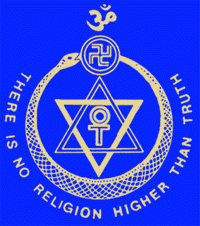Theosophical Society,

Life & Atoms
Study
Group notes April 2004
Prepared
by D Marsland
Live and Dead Matter
Theosophy maintains that
there is no dead matter in the universe. Science refers to dead matter as
inorganic matter and defines living matter as organic or as living organisms.
Theosophy does not make this distinction between live and dead matter but does recognise the difference between organic and inorganic
matter. Theosophy divides the material world into the mineral, vegetable,
animal and human kingdoms. These material kingdoms roughly correspond to Kant’s
Phenomenal Universe.
There are also 6 kingdoms
that fall outside the range of normal Human perception. There are three
kingdoms below and three above the material kingdoms on the evolutionary scale.
The three lower are the Elemental kingdoms comprising centres
of living energy which support the material kingdoms and the three higher
involve more evolved entities who organise and govern
our existence. These imperceptible kingdoms correspond to Kant’s Noumenal Universe. We would not regard these hidden
kingdoms as material but they would be material to themselves. Matter in all kingdoms has consciousness even
if this is at a level below our appreciation of it. Everything is evolving.
Despite modern science’s
distinction between organic and inorganic matter, most scientists now agree
that organic life arose from inorganic matter even if some regard it as a
chemical fluke.
At present although science
can identify and define organic life, the mystery of how it arose has not been
solved. Theories vary; some postulate that organic life will emerge
automatically on any earthlike planet (look at the current interest in finding
water on Mars). Other theories suggest that organic life arrived by meteor from
outer space, this still leaves open the question of how it arose. It should be
noted that organic life has been found deep underground in sandstone and in
thermal vents on the ocean floor where there is no sunlight.
The Theosophical view is
that all organic life (vegetable, animal and human kingdoms) arose from the
material of the Earth and that its existence and evolution form an integral and
essential part of the evolution and life cycle of the Earth.
Atoms
The concept of atoms goes
back to the Greek philosophers Leucippus of Miletus
born c490 BCE (the first atomist) and his pupil Democritus c460 - 371 BCE , who
elaborated the theory and whose work survives in greater detail. Democritus
postulated that atoms were the basic building blocks of all universes and that
they were physically indivisible. To account for the diversity of the universe
he claimed that they were of various shapes, hardnesses,
sizes and densities. To account for their diversity atoms contained component
parts but were solid and could not be broken down.
The theory of solid atoms
with component parts was revived during the renaissance and was handed down to
western science being developed further by John Dalton (1776 - 1844) who developed
a number of theories to explain the structure of matter and a system to
calculate the weights of atoms which he still regarded as solid. He introduced
the idea that elements are composed of atoms and combine to form compounds.
John Locke (1632 - 1704) challenged existing ideas by suggesting that matter
was composed of properties supported by a substratum.
Physicists William Thomson
(1824 - 1907) and Ernest Rutherford (1871 - 1937) established that atoms were
not solid but had a nucleus with revolving particles (protons & neutrons) a
structure similar to a mini-solar system.
Further advances have
discovered ever smaller particles with increasingly complex and inexplicable
patterns of behaviour.
In spite of scientific
advances the atom remains the smallest particle of matter which cannot be
subdivided without destroying its identity.
Atoms - Matter &
Spirit
Following Theosophy’s
premise of the
fundamental unity of all existence which states that spirit and matter are part
of one whole. Theosophy regards atoms as the ultimates
of Nature on the material side and Monads (individual life centres)
on the energy side. This gives us both a material and spiritual ultimate. Every
physical atom is therefore a life and is subject to physical and spiritual
evolution.
Life Atom
The term life atom is used
to describe the ensouling power in every physical
atom.
The Transmission of Life
Atoms
The term is used
differently to describe atoms which form an integral part of a man’s being and development. During
incarnation some atoms develop an affinity with our reincarnating ego and are
drawn to us in our next reincarnation. Some are passed on to offspring. This
migration takes place even at the higher levels of man’s constitution although
the atoms at that level would not be considered material to us. As a man
evolves the more material atoms are cast off and the man eventually lives in a
spiritual body.
A Final Word on Atoms
When you drink a glass of water,
it is mathematical certainty that it contains a least one atom that was drunk
by Plato. There are more atoms in a glass of water than glasses of water in all the
world’s oceans
Theosophical Society,